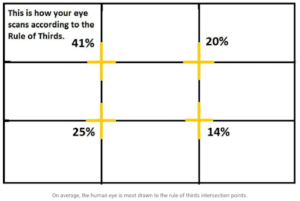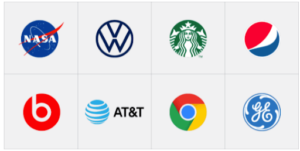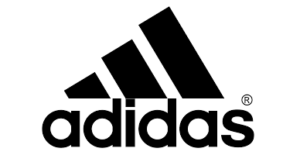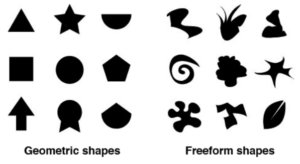Graphic Design Shapes: How to Use Shapes in Your Design
Need help selecting a company?
Based on your budget, timeline, and specifications we can help you build a shortlist of companies that perfectly matches your project needs. Get started by submitting your project details.
Use Geometric Shapes to Demonstrate Security
Geometric shapes are two-dimensional images that can be drawn using a ruler or compass and are very precise. Generally, the shapes you learned about in preschool, such as squares, circles, and triangles, are geometric shapes. Because they have straight edges, they portray a feeling of control and order. In fact, people can describe these shapes using mathematics. They’re often found in man-made things because they’re easy to reproduce, and everyone is familiar with them. Here are a few examples of geometric shapes that you’re probably familiar with and how they’re often used in design.
Squares and Rectangles
Squares and rectangles are very familiar to viewers, so they suggest peacefulness, security, and conformity. Because they’re evenly shaped, they’re often used to create outlines and structure. The human eye likes to move from object to object, and squares and rectangles can guide their attention to the most important parts of the design. For example, square and rectangular shapes are a great way to frame your design or organize your content. By dividing a page with two horizontal and two vertical lines, designers can create a grid.  Source: PhotoBlog By placing the most important elements at each intersection, designers ensure that viewers see them.
Source: PhotoBlog By placing the most important elements at each intersection, designers ensure that viewers see them.
Circles
Circles represent wholeness and continuity because they don’t have a beginning or an end. They’re associated with natural symbols like the sun, moon, and planets but can also represent balls, fruits, buttons, and more. They’re more welcoming than other shapes, so they can add friendliness and accessibility to your brand. Because they don’t have straight lines, they disrupt assumptions, and therefore, grab attention. Consequently, they can be used to highlight crucial parts of your design. Placing a circle behind an image or using it to frame an image are great ways to incorporate them into their designs. Circles are often used to create outlines in logos because they’re noticeable and powerful. Consider these brands who have chosen to use circles in their logos:  Source: Business 2 Community Here we see that Nasa used a circular logo to associate it with planets and space exploration, while AT&T did the same to emphasize global connection. However, Beats used the same shape to make the logo look like headphones, their primary product. Circles are often used to create movement as well. Many designers add animation to make these circles look like they’re spinning or rolling. Pepsi, for example, introduced the globe logo in 2008 to represent their global brand and often uses animation to show that it rotates on an axis.
Source: Business 2 Community Here we see that Nasa used a circular logo to associate it with planets and space exploration, while AT&T did the same to emphasize global connection. However, Beats used the same shape to make the logo look like headphones, their primary product. Circles are often used to create movement as well. Many designers add animation to make these circles look like they’re spinning or rolling. Pepsi, for example, introduced the globe logo in 2008 to represent their global brand and often uses animation to show that it rotates on an axis.
Triangles
Triangles lead to a point so that they effectively create direction in a design. Think about when you most often see triangles: play buttons and arrows showcase movement. You may also see them in association with mountains and pyramids. That’s because they also symbolize balance and stability thanks to their strong base. However, if they’re upside down, they represent risk because of the instability created at a point. Consider Adidas’s mountain-shaped logo. The triangle in this design represents consistent movement, growth, and overcoming challenges.  Source: Logaster This emphasizes continuous growth and performance, a key component of Adidas’ brand.
Source: Logaster This emphasizes continuous growth and performance, a key component of Adidas’ brand.
Use Organic (Free-Form) Shapes to Represent Nature
Organic shapes are naturally occurring shapes that can’t be manufactured; they have loosely flowing outlines and are often asymmetrical. Usually, you’ll see them as flowers, leaves, paint splatters, or water blobs. Unlike geometric shapes, organic shapes are often curvilinear.  Source: Slide Express Because they seem more natural, they’re great for environmental campaigns or to represent the outdoors.
Source: Slide Express Because they seem more natural, they’re great for environmental campaigns or to represent the outdoors.
Use Abstract Shapes for Symbols & Icons
Abstract shapes are recognizable shapes that depict real-life images but aren’t exact representations. They provide a visual representation to highlight general ideas, and therefore, are great for symbols, icons, and infographics. You can use them to replace text and provide a better understanding for your viewers. For example, you can use stars to emphasize important information. You probably see icons in everyday life. Email icons, for example, look like unopened mail, bathrooms that aren’t gender-neutral often feature stick figures on them, and road signs for wildlife crossings feature outlines of animals in the area. You may have also seen abstract shapes in popular logos. For example, Spotify, the streaming service, includes three curvilinear lines, stacked one on top of another within a circle. The three lines represent auditory waves and the digital nature of their company.  Source: Spotify Newsroom Consequently, viewers instantly can associate the logo with the brand.
Source: Spotify Newsroom Consequently, viewers instantly can associate the logo with the brand.
Shapes Enhance Your Designs
Geometric, organic, and abstract shapes can grab your viewer’s attention and help communicate your message. However, choosing the right shape for your design requires understanding your brand and what they’re associated with. While square shapes create form and structure, circles represent friendliness, and triangles showcase strength. While you may choose organic shapes for environmental campaigns, they may not be the best option for a tech company. However, abstract shapes can help you deliver your message by representing everyday objects.
Need help selecting a company?
Based on your budget, timeline, and specifications we can help you build a shortlist of companies that perfectly matches your project needs. Get started by submitting your project details.